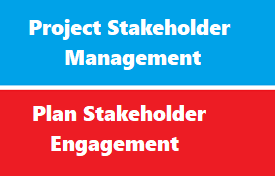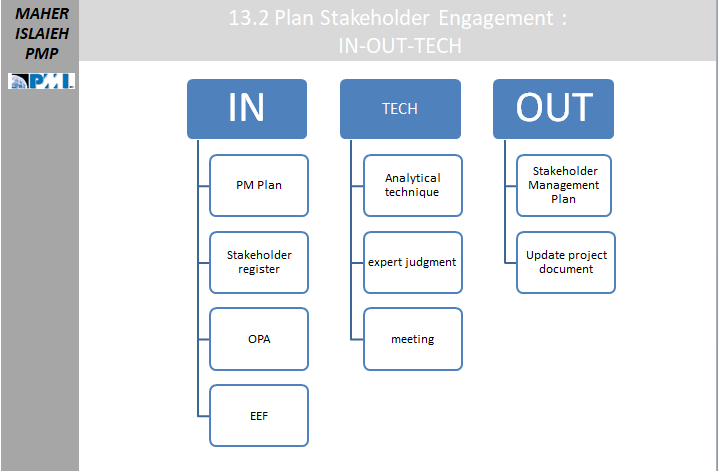introduction
Plan Stakeholder Management is the process of developing appropriate management strategies to effectively engage stakeholders throughout the project life cycle, based on the analysis of their needs, interests, and potential impact on project success.
The key benefit of this process is that it provides a clear, actionable plan to interact with project stakeholders to support the project’s interests.
A Stakeholder Engagement Plan is a formal strategy to communicate with project stakeholders to achieve their support for the project.
It specifies the frequency and type of communications, media, contact persons, and locations of communication events. It is created at the beginning of the project and updated frequently as stakeholder communication needs change.
How to Develop a Stakeholder Engagement Plan
developing a stakeholder engagement plan include the following steps :
- Classify Stakeholders
As an initial step in stakeholder analysis, classifying the stakeholders into defined groups can assist in the next, more detailed steps. Stakeholders can be classified into supporting or opposed, for example a project investor is a supporter and an environmental NGO is opposed. They can be divided into Upwards/Sideways/Outwards/Downwards, for example, upwards are executives from the parent organization, sideways are project suppliers and contractors, outwards are other projects competing for limited resources and downwards are the project team, suppliers and contractors. - Develop Power/Interest Grid
This is the primary stakeholder analysis It contains the power of the stakeholder on the y-axis, which is the ability of the stakeholder to stop and/or change the project, and the interest level of the stakeholder on the x-axis, which is the amount of overlap the stakeholder’s interests have with the project. This defines the stakeholder’s “stake” in the project. - Define Power
Although the stakeholder’s location on the chart is important, a verbal analysis of the power of the stakeholder is imperative to get a sense of how much influence the stakeholder has. For example, a government regulatory agency usually has extremely high power to stop the project – they can withhold their approval and stop the project immediately. The success of the project is heavily dependent on keeping them informed on an ongoing basis. - Define Interest
Once again, the location of the stakeholder on the chart is expanded and analyzed to determine what their interest in the project really is. The stakeholder’s business interests are analyzed and prioritized. Their needs and wants are described to a point where the stakeholder is well understood by the project management team. - Develop the Stakeholder Engagement Plan
The stakeholder communication needs are itemized based on the power and influence analysis. The type of communication and its frequency is specified. The other parts of the stakeholder engagement plan, described above, are more administrative in nature.
How to Improve Stakeholder Engagement
- Show the stakeholder you care
- Emphasize the human aspect
- Give stakeholders a voice
process inputs
Plan Stakeholder Engagement: Inputs
Project Charter
The project purpose, objectives, and success criteria can be used in planning how to engage stakeholders.
Project Management Plan
Here are the components of the overall project management plan that can be used for this process.
- Resource management plan–may contain information regarding roles and responsibilities of the team and other stakeholders listed in the stakeholder register.
- Communications management plan–the communication strategies for stakeholder management and their implementation plans are input to this process
- Risk management plan–may contain risk thresholds or risk attitudes that can assist in the selection of the optimal stakeholder engagement strategy.
Project Documents
- Assumption log–contains information about assumptions and constraints that may be linked to specific stakeholders. ]
- Change log–changes to the original scope of the project are usually linked to specific stakeholders who are requesting those changes, or who are involved in the decision about change requests.
- Issue log–resolving issues contained in the issue log will require additional communications with the stakeholders affected.
- Project schedule–contains activities that may be linked to specific stakeholder as owners or executors
- Risk register–contains identified risks of the project and links them to specific stakeholders either as risk owners or as subject to impact from that risk.
- Stakeholder register–the output of process 13.1 Identify Stakeholders. The preliminary list of project stakeholders, including additional data about their classification.
Enterprise Environmental Factors
- Organizational culture, political climate, governance framework
- Personnel administration policies
- Stakeholder risk appetites
- Established communication channels
- Global, regional or local trends
- Geographical distribution of facilities and resources.
Organizational Process Assets
Among the OPAs listed on p. 520 of the PMBOK Guide, here are the ones that I feel are the most relevant to this process.
- Corporate policies and procedures for social media.
- Corporate policies and procedures for issue, risk, change, and data management.
- Lessons learned repository with information about the preferences, actions, and involvement of stakeholders
process techniques
Plan Stakeholder Management: Tools and Techniques
Expert Judgment
expert judgment should take care of :
- Politics and power structures in the organization and outside the organization
- Analytical and assessment techniques to be used for stakeholder engagement processes (especially the stakeholder engagement assessment matrix)
- Communications means and strategies
- Knowledge from previous projects regarding individual stakeholders and stakeholder groups that were involved in previous similar projects.
Data Gathering
- Benchmarking is a data gathering technique which compares the results of stakeholder analysis in the other tools and techniques for this process and compares them with information from other organizations.
Data Analysis
Data analysis techniques used for this process include:
- Assumption and constraint analysis–analysis of current assumptions and constraints may be conducted in order to tailor appropriate engagement strategies.
- Root-cause analysis–identifies underlying reasons for the current level of support of project stakeholders in order to select the appropriate strategy to improve their level of engagement.
Decision Making
- Prioritization and ranking of stakeholder requirements is important, as is the ranking of the stakeholder themselves.
- Those stakeholders with the most interest (those impacted by the project) and the highest influence (those who can impact the project) are often prioritized at the top of the list.
Data Representation
These are used to help in data analysis and decision making
- Mind mapping–visually organizes information about stakeholders, their relationship to the project, to each other, and to the organization doing the project.
- Stakeholder engagement assessment matrix. This supports comparison between the current engagement levels of stakeholders and the desired engagement levels required for successful project delivery. Here is one way of classifying stakeholders:
- Unaware–unaware of the project and potential impacts: obviously you want to make these stakeholders aware, which means then they will turn into one of the following four classifications
- Resistant–aware of the project, and resistant to any changes that may occur as a result of the work or outcomes of the project. These stakeholders will be un-supportive of the work or outcomes of the project. They might turn neutral or even supportive if you are able to address their concerns, which may involve changes to the project that mitigate the impact it will have on them and their department.
- Neutral–aware of the project, but neither supportive nor nonsupportive, usually because it doesn’t affect them. With these stakeholders, it is important to monitor if their position in the organization changes, because that may change their position with regards to your project.
- Supportive–aware of the project, and supportive of the work and its outcomes.
- Leading–aware of the project, and actively engaged in ensuring that the project is a success. This last group is a separate one from “supportive” because the leading stakeholders can help you evangelizing to the rest of the organization. In addition, if they are members of senior management, they will be the ones to do the heavy lifting in terms of communication with other members of senior management who are resistant to the project, mainly because they influence over those members where you as a project manager do not. It should go without saying that you should always have at least one leading stakeholder on every project, namely, the project sponsor.
process outputs
Plan Stakeholder Engagement: Outputs
Stakeholder Engagement Plan
- This identifies the strategies and actions required to promote productive involvement of stakeholders in the decision making process and the execution of the project plan.
- The stakeholder engagement plan may include specific strategies or approaches for engaging with individual stakeholders or groups of stakeholders. The stakeholder register is the main focus of this plan.
A stakeholder engagement plan contains the following parts:
- Stakeholder list
The first step in any stakeholder engagement plan is to list the stakeholders. But it’s important to be thorough because it’s easy to underestimate the ability of a minor stakeholder to trip up the project when they’re not being communicated with adequately. According to the PMBOK, this list is called a Stakeholder Register, and it is created as part of the Identify Stakeholders process. - Project phase
Many stakeholders will be involved in only a certain phase of the project. - Contact name(s)
It’s important to be in contact with the correct people. Large organizations or government (regulatory) stakeholders have many layers of bureaucracy which can result in project delays when the primary decision maker is not being communicated with directly. - Areas of Influence
This is where the stakeholder’s “stake” is defined. How do their interests overlap with the project? What are their business goals and how does your project interfere with them? Why is this stakeholder interested in your project? There can be no meaningful stakeholder engagement without understanding each other’s viewpoints. - Power
Each stakeholder has a unique ability to stop and/or change the project. What is that ability? Where does it derive from, and how can it be controlled? Sometimes the stakeholder’s power over the project can be removed, but this comes at a cost, both monetary and in stakeholder satisfaction (they could become very unhappy and influence other stakeholders). - Engagement approach
The strategy for engaging the stakeholder must be outlined in detail. The types and frequency of communication, for example weekly emails, monthly phone calls, or weekly face to face meetings. The content of those communications, for example a weekly update that contains project progress, design information, and open house plans.


